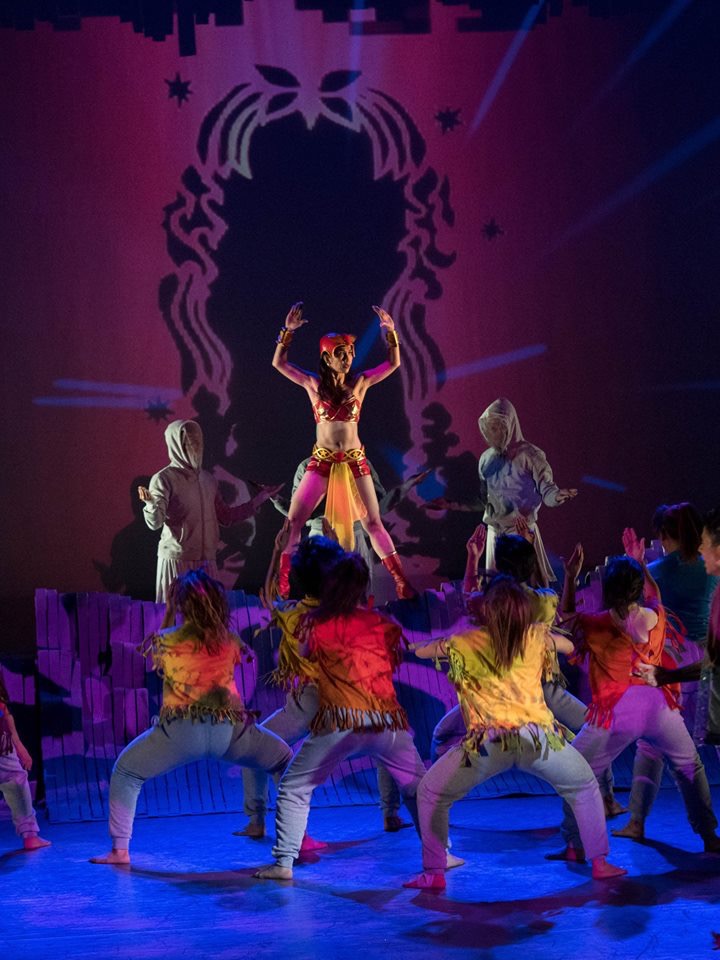
The College of St. Benilde’s Arts and Culture Cluster’s (BACC) recent production of the dance musical “Ding, Ang Bato!” emerged not just as a pleasant surprise, but also as a theatrical triumph on all counts where dance productions are concerned.
While based on Mars Ravelo’s 1950 comics classic “Darna,” the perspective of the play has been shifted from the superheroine’s eyes to her deaf-mute brother Ding—yet another mutation among the many versions the original story has seen through the years.
Spot-on
The dance, which used movement instead of words to drive the narrative, became the spot-on art genre in this version. Obvious traces of Agnes Locsin’s legacy could be seen in the way the dancers moved in the rather lengthy danced prologue. Not surprising, as BACC’s dance director, Christine Crame (who played Darna), was in Locsin’s roster of Ballet Philippines II dancers a few years back.
Choreographers Denisa Reyes and Ernest Mandap made use of this training in full. The marked minute movements said a lot: a twitch of a muscle, isolations, Locsin’s trademark angular neck movement akin to a Hindu temple dancer’s move, the walks in squat position.
Majority of Locsin’s favored dance themes were of ethnic origin, and these movements, which she developed for her repertoire, became her trademark. With the Reyes-Mandap collaboration, the choreography and execution exhibited a hybrid legacy of three of the country’s iconic dance figures.
Was the sign language incorporated in the choreography necessary, given that dance stories employ balletic mime? To define the muteness of Ding in a wordless performance genre, it was perhaps deemed essential. The sign language movements, then, became integral to the choreography, the intensity of the movements increasing with the tension of the plot.
In his notes, director-librettist Chris Millado said the choreographers worked closely with instructors from the School of Deaf Education and Applied Studies and the deaf members of the cast “to come up with a movement vocabulary that was inspired by sign language.”
Merry mix
Composers Jef Flores and Ejay Yatco, meanwhile, are two examples of stage actors diversifying into other areas of theater production.
Yatco is an actor, composer, musical director and pianist. His work as musical director of Repertory Philippines’ “Hair” last year earned him a Gawad Buhay trophy. He was also a four-medal winner at the World Championship of Performing Arts.
Flores, a two-time Gawad Buhay honoree for acting and singing roles, is now a “triple threat” performer, after studiously taking dance workshops. And with his successful attempt at composing, musical arrangement and direction for “Ding, Ang Bato!,” his “threats” now add to four in all.
As a tandem, Yatco and Flores made a definite statement with their original contemporary music score that was a merry mix of electronica, hip-hop, beat box and more.
The production elements were as imaginative and well put-together. Indonesian shadow puppetry blended with the dancing, while digitized or synthesized vocals gurgled by a lone singer in the background energized the fight scenes.
Speech bubbles were used in lieu of the spoken word, along with Asian symbols like Chinese clouds, dragons and waves. The use of modern electronic-like abstract designs made for a cacophony of layers—not overwhelming, but instead enhancing the scenes in well-balanced sensory landscapes.
Grace, power
The role of Ding was played significantly by a deaf actor, alternate Juner Quiambao. Three other members of the cast were also deaf.
The role of Darna was a nonspeaking, flying and fighting part. It required the dancer to possess agility of movement, grace and power. Ravelo’s original idea was for Darna to be a tall, Amazon-like woman. What Olivia Bugayong (alternating for Crame) lacked in height and stature, she made up for with strength in movement, exemplified by defined poses and a convincing fighting form, capped by a triumphant smile.
In contrast, Sarah Garcia’s Narda was properly frail and seemingly helpless, gaining her strength of spirit as the play progressed. Like Olivia’s Darna, her nemesis, Valentina, was played by petite Natasha Cabrera, so that was a fair match.
Elijah Mendoza as Maligno was convincingly menacing with his gang of Galamays—Michael dela Torre, John Gamboa and Mark Juelar.
The use of adult-size “slinkies” for arms and instruments of torture was ingenious. Using a child’s toy as the visual characterization of evil in a mischievous manner was disturbing, as it resonated with all-too-familiar situations where the powers that be take citizens for a ride in their pitch for power, their greed exemplified by slurping tongues, sleek suits and square haircuts.
In “Ding, Ang Bato!,” the freedom to experiment—boosted by the proper resources from the school, the expertise of the creative team and the personal perspectives of the cast members—made for a holistic endeavor that proved highly rewarding and satisfying in the end. —CONTRIBUTED













































